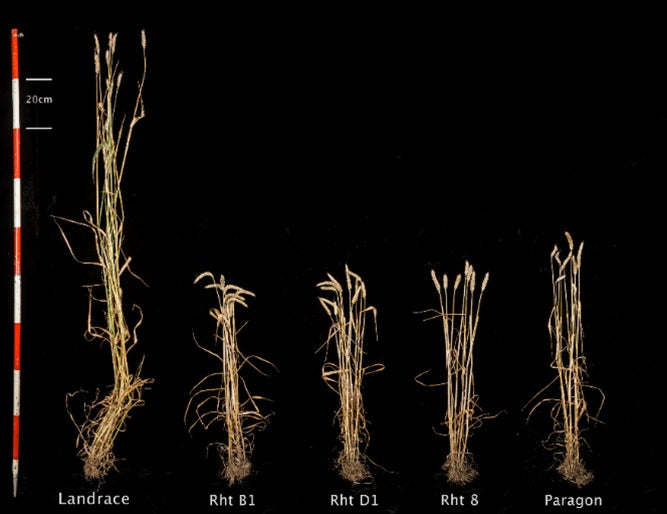Why do we love offering heritage and ancient grains? One reason is their superior nutritional content. Pictured here is a landrace heritage wheat (left) next to several varieties of modern semi-dwarf wheat. Landrace refers to a cultivar that has developed and adapted over time to a local geographic region. It has genetic diversity and is able to adapt to varying conditions in its region. We look forward to diving in to the benefits of genetic diversity and its value in sustainable agriculture another time. Modern wheat arose in the mid 1900's and has been bred to have specific characteristics suitable to modern agriculture, including shorter stalks to prevent lodging (falling over when the seed head becomes large and ripe) and to allow for easier combine harvesting, and large seed heads to increase yield per acre. When the plant is bred with shorter stalks it is able to invest more of its energy into seed head production rather than leaf production. These wheats were developed with the goal of increasing food production world wide. Food quantity certainly has value, however it needs to be measured against food quality. Increased yield and suitability to modern agricultural practices were paired with suitability to modern food production practices. Modern wheats have also been bred to provide strong gluten structures that can withstand intense mechanical mixing and provide strong structure for bread. The change in modern gluten structure is another topic we look forward to discussing in depth in the future.
In this picture we can see the difference between heritage and modern wheats above ground, but what we see here is also mirrored below the soil, with heritage varieties having much deeper, extensive root systems. Interestingly, within a species, shorter stalks are genetically linked to smaller root systems - the traits can't be separated. This means that, when looking at the same species, a larger plant above ground will reflect a larger root system below ground. Extensive root systems are an important part of soil ecosystems, stabilizing the soil, helping with water retention, sequestering carbon, and allowing mycorrhizal fungi and other micro-organisms to thrive. These organisms play important roles like fixing nitrogen and decomposing organic matter, creating nutrient rich soil for crops to grow in. The extensive root systems of heritage plants allow the plant to access more nutrients, including potassium (K), nitrogen (N) and trace minerals valuable to our diet, from the soil. Deep root systems also allow plants to uptake more water, especially in drier or rockier environments, decreasing the need for additional water input, or irrigation, to thrive.
In addition to extensive root systems, long stalks contain more leaves for photosynthesis which is a vital source of sugar for the plant. Although this may be surprising, sugar content in a plant can often reflect nutrient density for a few reasons. Healthy plants transfer sugars through their roots to the surrounding soil, feeding micro-organisms that, in turn, produce minerals that the plant can uptake. These minerals are important as co-enzymes for plants to produce proteins. Adequate sugar also allows the plant to produce fats that, within the plant membrane, serve as an important protection against pathogens. Adequate fat also allows the plant to produce compounds that are a deterrent to bacteria, fungi and insects. We will enjoy the greatest nutritional impact from plants that have not been damaged by insects, disease or other pathogens. Higher sugar content also has the added benefit of better flavour!
There is much more to discuss, including the value of stone-milled, whole grains, and the difference that preparation methods have on the nutritional value of grains. But, at its simplest, lots of leaves for photosynthesis, and extensive root systems for healthy soil and increased nutrient uptake results in high nutritional content! The type of wheat we eat does make a difference, and we love to make delicious, nutrient dense varieties from passionate local farmers accessible to you!

